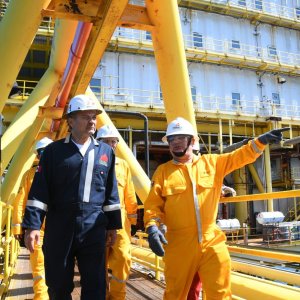Megatrends: The Future That Is Awakening

STORY INLINE POST
Businesses are facing a new reality after the pandemic, which has been a catalyst for several disruptions. Society as a whole has been transformed. On the one hand, during the first part of the health crisis, we dealt with a virus that we knew nothing about, and that we gradually learned to live with, reducing the chances of contagion. On the other hand, the world, from an economic point of view, had to keep on going: organizations, governments and companies turned technology into their best ally to continue generating wealth.
This period has had a very high cost for Mexican society. According to data from Statista, by the beginning of 2022, the virus had caused the death of approximately 320,000 people. According to INEGI data, between the months of March and April of 2020 alone, 12.5 million jobs were lost, of which 10.4 million were informal. Additionally, nearly 1.6 million businesses had to close.
All these changes have transformed the way millions of people live and work. In the end, crises also cause opportunities that bring new modes of life and wealth generation. In this sense, organizations will have to continue reconfiguring themselves to maintain their viability.
The order of the priorities that the pandemic left behind – which we still have not fully understood – has thrown us into a new reality that is accompanied by new challenges to which we will have to adapt. First, to confront them, it will be important to internalize the lessons that the crisis has taught us, and then recognize the challenges that we will face. This will help us, without a doubt, to identify the tools that we have at hand, use them and continue navigating in these waters of constant change, evolution and adaptation.
At PwC, we work with organizations around the world to try to understand these important changes, and we have identified five megatrends that are impacting society as a whole and are also giving businesses a new direction. These megatrends will challenge everything, especially businesses and government leaders, who will be tasked with understanding where they will need to stand to help society prosper over the next decade.
1) Urbanization
The global figures are conclusive: In the 1800s, only 2 percent of the world's population lived in cities. Today, 50 percent of the population lives in them. According to information from INEGI, in Mexico, in 1950, 43 percent of the population lived in urban locations; in comparison, 79 percent lived in these locations by 2020. What does this imply? A growing demand for infrastructure and strong pressures in terms of the environment and the social fabric of cities. In addition, these metropolises consume most of the world’s natural resources. One thing to consider is that 50 percent of the world's GDP is generated by the 300 largest metropolitan areas. In addition, we estimate that in 2025 there will be about 40 cities with a population greater than 10 million people.
To face these challenges, technology will have to be the greatest ally. Some governments are already beginning to develop new smart cities. An example is the city of Masdar in Abu Dhabi. Another alternative is to apply technology horizontally to make better use of cities; so that cities can grow, remain habitable and be self-sustainable.
2) Demographic and Social Changes
It is estimated that by 2025, there will be a total of 8 billion inhabitants on the planet. Our life expectancy has increased and we are having fewer children. This has resulted in a growing population of people over the age of 65. Africa is the region that is beginning to have the youngest population. In addition, its population will double by 2050. By that same year, Japan will have an average age of 54 and Nigeria of 21. This reality will require countries to be more audacious in terms of policies that can sustain these demographic changes. Regions such as Europe, Asia, and Latin America will require a larger workforce, increased participation of women in the economy to support economic needs, and increased participation of diverse talent. Given this context, migration is the first answer to sustain an aging population.
The emerging economies, for their part, will have to face their own challenges in terms of demographics within a much shorter period. France, for example, took a century to double the share of people over 60 in the workforce. Could an economy like ours take that long?
3) Climate Change and Resource Scarcity
The demand for energy, food and water will be increasing if we consider population growth. However, we cannot stop the depletion of resources either. If we start from current consumption trends, we could assume that we only have 50 years of available proven reserves in oil and gas. In addition, this means higher carbon emissions and an even warmer climate. This scenario could reduce agricultural productivity by up to a third for the next 60 years, especially on the African continent.
It is very likely that this reality will force rulers to let themselves be carried away by short-term reactions to the natural events that we gradually experience. Given this, we believe that organizations should take a leading role in mitigating damage, without neglecting their levels of adaptation.
4) Change in Global Economic Power
By 2030, we estimate that the countries that belong to the E7 (China, India, Russia, Brazil, Mexico, Turkey and Indonesia) will surpass the purchasing power of the G7 countries. In 2010, we had already predicted that by 2015 the Asia-Pacific region would have a larger middle class than even the European and North American regions combined.
Since 2000, for example, the Chinese economy has tripled in size, while Mexico's has only grown by a third. In this sense, for emerging countries like ours, there are still important challenges, and a new vision of the global economy.
Among the trends in this regard is that some emerging markets will transfer their value chains to their own nations. This will make them a hub for global business. They will also become hotbeds of highly-skilled talent, causing large conglomerates to be run by people from emerging markets. This will result in a more diverse business environment.
5) Technological advances
According to our 2021 Global CEO Survey, technology was already the top concern for company CEOs. The fact that it takes less and less time to reach the masses has caused the economy to reconfigure itself in various aspects. For example, it took 76 years for the telephone to reach half the US population. The smartphone took less than 10.
The technological transformation potential for the next decade is immense, and very specifically in the consumer market. In this sense, we believe that this transformation will take place over three digital waves: The first wave refers to the adoption of a digital channel, which we are seeing even in the most traditional companies. The second wave refers to the facilitation of an economy of results, in which information shared through connected devices helps customers achieve certain results. The third wave will be driven by consumers who will become more aware of the importance of their digital identity and will extract greater value from it through platforms that allow them to manage their consumption. This last factor will cause companies to evolve in four key aspects of digital: social, mobile, analytical and the cloud.
The Great Challenge...
Companies will be impacted not just by one megatrend, but by the interaction of several. They will suffer a collision, a disturbance. This will cause them to question what they have done so far and try to understand where they should turn the rudder so as not to lose focus. We will have to analyze these megatrends and the series of effects they will have on society to try to have an even broader vision of our increasingly interconnected and interdependent economy.
To navigate this transformation and come out of it successfully, companies must begin to question aspects, such as how clear the purpose of the organization is in the context of megatrends, and be aware of how well aligned activities and people are toward this purpose. In addition, they will need to be ready to determine the rate of change for the organization to survive and thrive. All this without losing sight of the importance of identifying what will be the trigger for change in the organization and how it will create new sources of value.
























